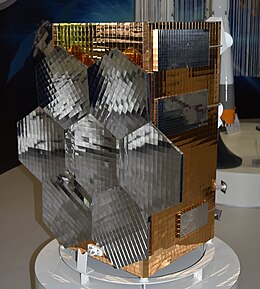 A model of the Mikhailo Lomonosov | |||||||||||||||||||
| Mission type | Astronomy | ||||||||||||||||||
|---|---|---|---|---|---|---|---|---|---|---|---|---|---|---|---|---|---|---|---|
| Operator | MSU | ||||||||||||||||||
| COSPAR ID | 2016-026A | ||||||||||||||||||
| SATCAT no. | 41464 | ||||||||||||||||||
| Website | lomonosov.sinp.msu.ru | ||||||||||||||||||
| Mission duration | Planned: 3 years [1] | ||||||||||||||||||
| Spacecraft properties | |||||||||||||||||||
| Manufacturer | VNIIEM | ||||||||||||||||||
| Launch mass | 620 kg (1,370 lb)[1] | ||||||||||||||||||
| Payload mass | 170 kg (370 lb)[1] | ||||||||||||||||||
| Power | ~300 W[1] | ||||||||||||||||||
| Start of mission | |||||||||||||||||||
| Launch date | 28 April 2016, 02:01 UTC | ||||||||||||||||||
| Rocket | Soyuz-2.1a/Volga | ||||||||||||||||||
| Launch site | Vostochny Site 1S | ||||||||||||||||||
| Contractor | Roscosmos | ||||||||||||||||||
| End of mission | |||||||||||||||||||
| Deactivated | 14 January 2019 | ||||||||||||||||||
| Decay date | 16 December 2023 | ||||||||||||||||||
| Orbital parameters | |||||||||||||||||||
| Reference system | Geocentric | ||||||||||||||||||
| Regime | Sun-synchronous | ||||||||||||||||||
| Semi-major axis | 6,856 kilometers (4,260 mi)[2] | ||||||||||||||||||
| Perigee altitude | 478.2 km (297.1 mi)[2] | ||||||||||||||||||
| Apogee altitude | 492.9 km (306.3 mi)[2] | ||||||||||||||||||
| Inclination | 97.3 degrees[2] | ||||||||||||||||||
| Period | 94.2 minutes[2] | ||||||||||||||||||
| |||||||||||||||||||
Mikhailo Lomonosov (MVL-300, or Mikhailo, or more commonly Lomonosov; MVL stands for Mikhail Vasilyevich Lomonosov[4]) was an astronomical satellite operated by Moscow State University (MSU) named after Mikhail Lomonosov.[5]
- ^ a b c d "Космический аппарат "Ломоносов"" [The spacecraft "Lomonosov"] (in Russian). VNIIEM. Retrieved 21 March 2016.
- ^ a b c d e "MVL 300 Satellite details 2016-026A NORAD 41464". N2YO. 4 May 2016. Retrieved 4 May 2016.
- ^ ELFIN-L consists of three components: a flux gate magnetometer (FGM), an electron particle detector (EPDE), and an ion proton detector (EPDI)
- ^ Cite error: The named reference
Gunterwas invoked but never defined (see the help page). - ^ Cite error: The named reference
sfnwas invoked but never defined (see the help page).